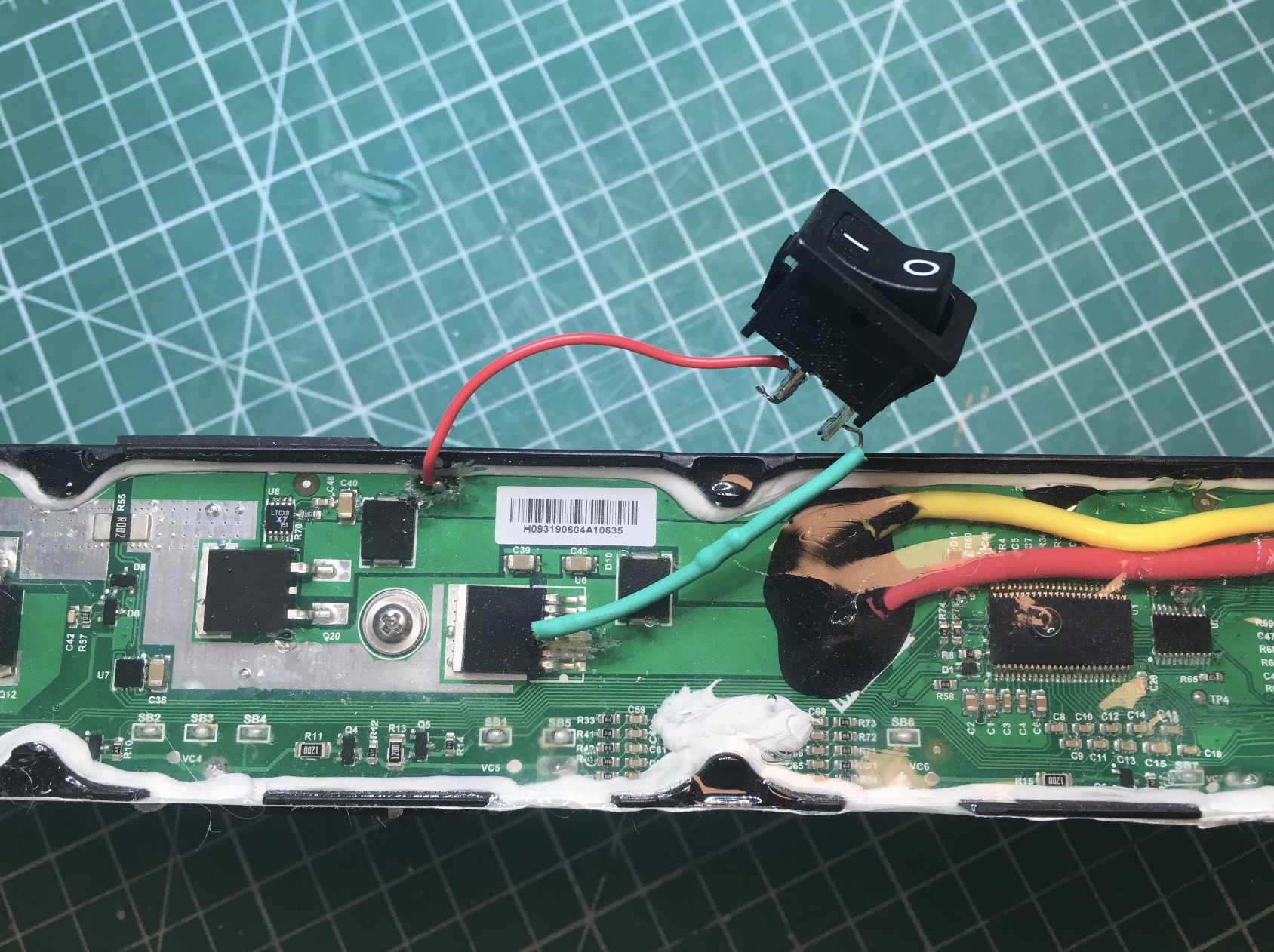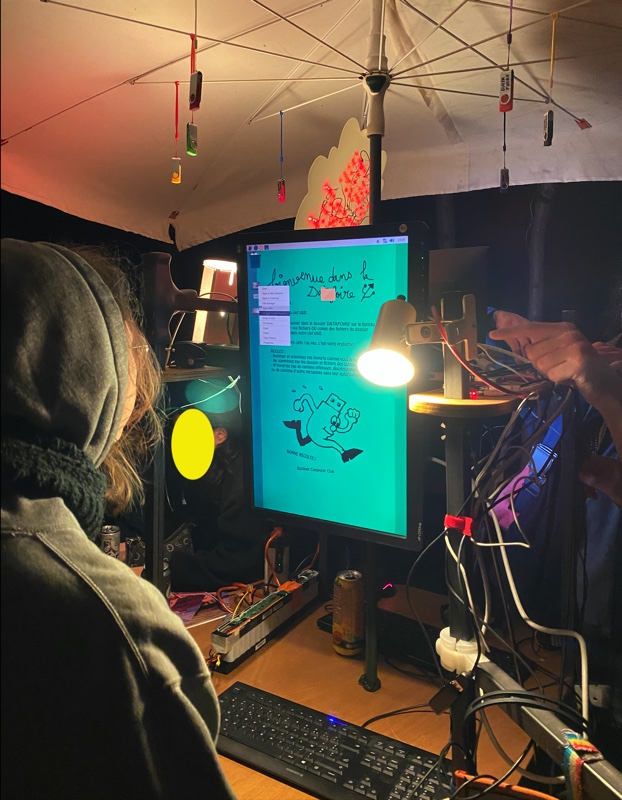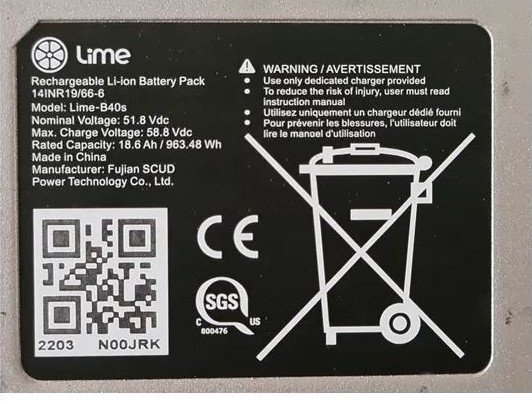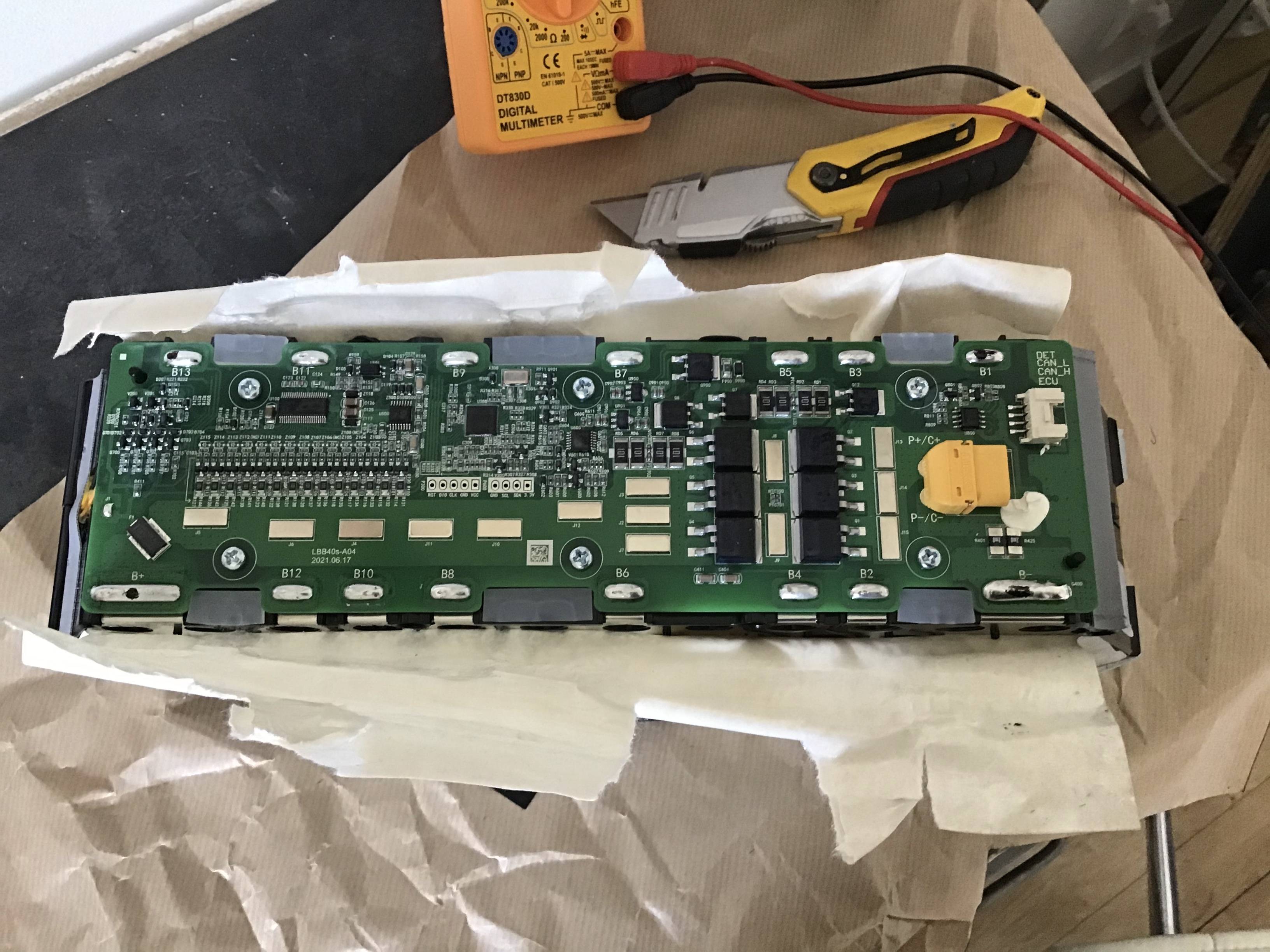Batteries
Informations sur les batteries
Batterie Jump
Type : Li-On
Nominal Capacity : 12.8Ah
Rated Capacity : 12Ah 37V 444Wh
MH1 cell
controleur pour batterie jump
tutoriel pour faire fonctionner le controlleur
Plan :
- Connecter les 5 batteries Jump en parralele et utiliser 1 Jump CAN controller pour les reveiller et les utiliser telles quelles
- Trouver un objet pour step down le voltage de 37V à 12V et 24V (ou juste 12V car on a déjà les boosters 12v-24v)
Pb : Le controlleur est out of stock
projet de reverse engenier du BMS de Jump
Il est possible cependant de televerser le code necessaire, dans un autre controlleur STM32F103
code your own
Apparment il est aussi possible de l'activer sans : JAG35 40 cell LG MH1 Battery BMS 3rd Pin Hack
ce qu'on à reussi à faire :
On a bypassé les restriction du BMS en connectant une resistance 1k entre le ground (TP1) et la troisieme patte de la chip sur la photo. L'interrupteur permet donc d'eteindre et allumer la batterie
*Il aurait fallu mieux securiser ce hack car il s'est cassé il a fallu le resouder, non sans peine -> Améliorer la fixation *

On a ensuite pu charger les deux batteries hackés, et enfin avec ce convertisseur 37v -> 12v , suivi d'un convertissreur de voiture 12V vers 230V (acheté à Leclerc) on a pu optenir un 230V stable.

1 batterie à alimenté pendant 4h 3 lampes (basse consommation) 2 raspberry pi et 2 moniteurs d'ordinateur

Choisir le chargeur
how to choose a battery charger
- Prendre un chargeur le plus lourd possible : meilleurs composants
Visite de Daurema !

Dimanche 19 mars 2023, on est allé avec M et L visiter l'attelier de T, à Anderlecht (BE). T reccupere et démonte des batteries Li-Ion de velo éléctrique pour reccuperer les cellules qui les composent, les tester et les remonter dans des nouvelles batteries qu'il fabrique. Leur particularité est qu'elle sont sans soudure (comparé aux batteries traditionnelles dans lesquelles les cellules sond soudées avec des bandes de nickel) Cette particularité permettrait leur réparabilité à moindre coûts/ avec le moins de machines outils necessaires.

T nous a filé pas mal de conseils pour notre propre situation.
La solution la plus simple serait de conserver les batteries que l'on trouve dans leur boitier plutot que de recomposer des batteries depuis les cellules car on aurait pas besoin de deux machines cheres : 1) Le testeur de cellules, 2) Le soudeur à point. Et ca prendrait moins de temps
Ce qu'il faudrait c'est de trouver des batteries identiques, de tester leur capacité avec un Programmanble Diselectric Load / Battery Electric Load. Ensuite les associer en equillibre selon leur capacité, en parallele. Il faudrait les charger avec un chargeur a la tension de sortie egale à la tension max de la batterie (42V), et brancher un stabilisateur/convertisseur de tension pour reccupérer du 12V stable en sortie. Il faudra penser à dimensionner le cable en fonction de la puissance traversée. Il faut aussi trouver un chargeur adapté pour charger toutes les batteries en fonction des cellules et de leur agencement.
A Acheter :
- convertisseur 30-42V(DC) → 12V(DC) celui la peut être
- chargeur 42V celui la ??
- connecteurs XT dimensionnés au courant la
- cables souples avec un petit AWG, american wire gauge = section (petit awg = grosse section)
- Lecteur de tension
Batteries Lime B40s
Battery Specs:
14INR19 66-6
- Nominal voltage : 51.8 Vdc
- Max Charge voltage : 58.8 Vdc
- Capacity : 18.6Ah : 963.48 Wh
"
to summaries there are 3 options
1) bypass the BMS for the loading with its associated risks -> easy to implement solution
2) change the BMS, it is not that easy but feasible
3) crack the code to unlock it from the CAN BUS
"




Les batteries lime sont assez présentes sur les trotinettes et les velos dans paris, On dirait qu'elles sont impossibles a emprunter mais apparement ce n'est pas le cas :
lime battery removal
A esssayer
Apperament selon les commentaires le tricks de la video marche pas, mais il y a un utilisateur de Scooter Talk qui parle de sortir les batteries a la meuleuse ici
La on en a 3 a disposition
Apparement selon ce thread il faudrait remplacer le BMS par un 14S et charger la batterie avec un chargeur 59V ce style
Batterie de velo Dott NEE1009-W
Battery Specs :
- 36 VDC
- 27900 mAh / 1004Wh
- Samsung INR18650 32E cells (x90)


Pour le moment je ne trouve pas de solutions pour bypasser ou flasher le BMS
10s li-ion charger 36v nominal, 42 volt end voltage. Around 6 Amp is preferred
2
Infos batteries
The voltage in LiPo (Lithium Polymer) batteries is determined based on the number of cells they have and we can easily identify this by referring to the "S" count.
Each LiPo cell is rated at 3.7v so a 2S LiPo means it's a 2 cell battery and 7.4v, a 3S is 11.1v, 4S is 14.8v and 6S is 22.2v.
BMS
A quoi ca sert
Lithium-ion batteries do not require a BMS to operate. With that being said, a lithium-ion battery pack should never be used without a BMS. The BMS is what prevents your battery cells from being drained or charged too much. Another important role of the BMS is to provide overcurrent protection to prevent fires.
BMS modules are not expensive (compared to the rest of the battery pack) and they are relatively easy to install. So, there is really no reason to not use a BMS. There are a few super special and rare situations where it may make sense to not use a BMS, but they are outside of the scope of this article.
Overcurrent Protection
Detection circuitry inside the BMS continuously monitors the current flowing through the BMS discharge MOSFETs. If this current rises above a certain threshold, the BMS switches off the MOSFETs and effectively removes the battery pack's electrical connection to the outside world.
Undervoltage Protection
The BMS will monitor the cell voltage of each cell group and if any of them go lower than a certain threshold (usually around 2.6 volts), the BMS is disconnected so that the battery cells don’t get damaged.
Overvoltage Protection
When charging a lithium-ion battery, a high voltage is applied across many sets of lithium-ion cells in series. If any one of the cell groups reaches the maximum charge voltage of a lithium-ion battery (4.2 volts), then the charge MOSFETs will be switched off to prevent overcharging the battery cells.
Cell Balancing
The difference between each cell group is monitored in the BMS. The cell group is detected to have a slightly higher voltage than the other cell groups, a small balance current is applied to the cell group. Over time, the high cell group’s voltage is brought down to the other cell groups. Balancing is handled by several small wires which go from the BMS to each cell group.
Connectivity Features
Higher-end BMS modules will either include a built-in Bluetooth interface or a generic UART interface that a Bluetooth module can be attached to. In some cases, you can even hook a USB cable up to your computer and manage your BMS from your PC.
Temperature Monitoring
Monitoring the temperature of the battery pack is an important but optional component of a BMS. In most cases, a properly designed system with a functioning BMS won't ever get hot enough to need to monitor the temperature.
Lithium-iron-based batteries, however, can be damaged if they are changed while being below a certain temperature. So, temperature monitoring is much more common for those types of cells.
Comment choisir
How To Know What Size Of BMS To Get
When someone refers to the ‘size’ of a BMS, they are generally referring to the maximum amount of current the BMS can handle. You need to make sure to get a BMS that can support the amount of power that is required by your load.
In fact, it's a good practice to add about 15% more current carrying capacity just so you have a little bit of headroom. After all, you don't want to run your BMS (or anything else, for that matter) at its absolute maximum ratings.
Let's say you have a 1000W inverter that you want to be able to safely run at max load. In this example, we will consider a 7S lithium-ion battery running a 24-volt AC inverter. A 7S lithium-ion battery has a fully charged voltage of 29.4 volts and a dead voltage of about 18.5 volts.
Drawing a 1100W load from the battery pack will require around 37 amps when the battery is fully charged.
1100 watts ÷ 29.4 volts = 37.4 Amps
At first glance, it may seem like you just need a 45 amp BMS. After all, your peak current will only be 37.4 amps, and adding an extra 15% to that comes to just 43 amps.
But wait.
When the battery is nearly dead, the voltage will be much lower. So, what happens when the amount of watts that you need stays the same but the voltage goes down?
The current goes up.
1100 watts ÷ 18.5 volts = 59.5 Amps
As you can see, you have to plan for the maximum amount of current that your battery will have to provide at its lowest voltage. So, in this example, you would want a 70 amp BMS.
BMS Current
Pour une batterie de 51V un bms de 20A de discharge et 4A de charge c'est cool. Ne pas prendre un BMS avec plus de discharge car la batterie ne pourra pas necessairement fournir la quantité demandée par l'appareil.